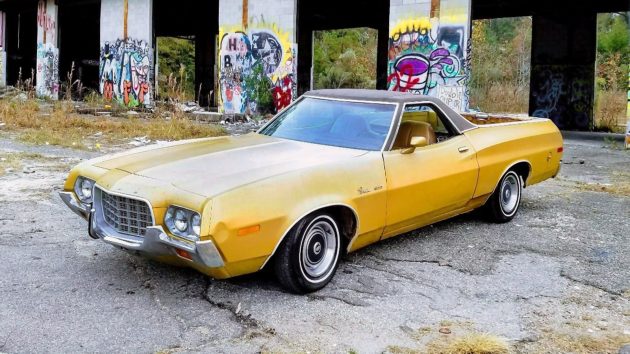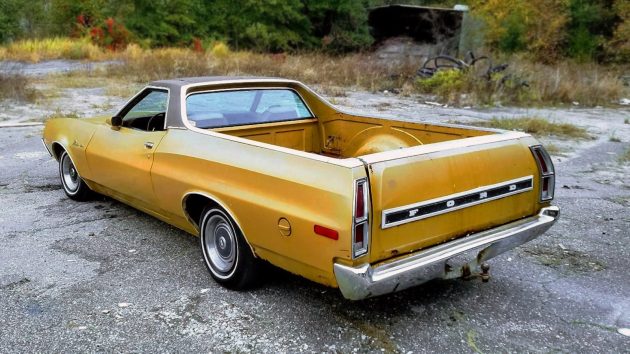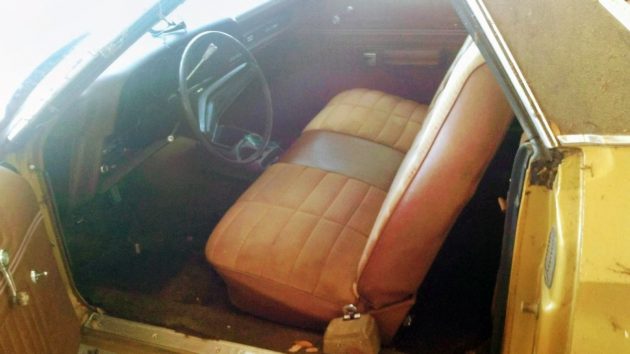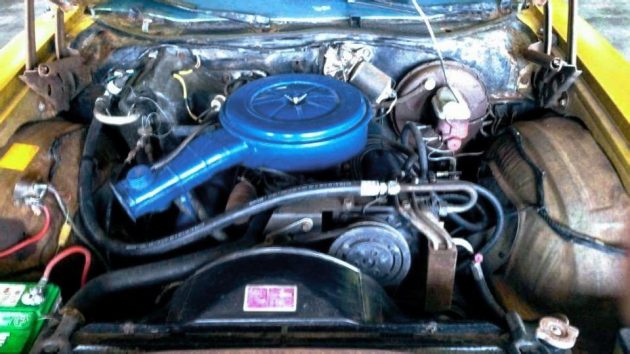1972 was the first year for the sixth-generation Ranchero, that alone is an impressive record for a car-pickup that isn’t quite a pickup and a pickup-car that isn’t quite a car. I think it’s great that Ford sold enough of them to be able to continue to make a financial case in updating this model for over two decades. I would argue that the Ranchero, and Chevy’s El Camino, and other car-pickups, were the predecessors to the posh, never-off-road, cup-holder-adorned, leather-lined pickups that a lot of people commute with today, since they want the comforts of a car and the utility of a pickup. Luckily gas is $2.00 a gallon or that would shift like it has in the past, and will again. This direct ancestor is a 1972 Ford Ranchero 500 and it is in original condition, according to the seller. It can be found here on eBay with a current bid price of $1,200 and the reserve isn’t met.
You can see that there will be work to do here. Although, I always automatically think that most vehicles need to be fully restored to like-new condition and that’s not the case. Sometimes, or more often than not (?), vehicles can just be maintained, fixed and updated as needed, and enjoyed as they are; rust, dents, and all. This may be one of those cases. Hagerty values a #4 “fair” condition 1972 Ranchero as $4,200 and a #3 “good” condition example as being worth $9,100, so maybe it would be safe to tear into this body if you can do the work yourself.
I have to admit, I’m a big fan of the previous Ranchero over any other generation, at least of the non-Falcon Rancheros. This example will test your welding abilities, but you can do it! This is the standard Ranchero 500, Ford also offered a Ranchero Squire and probably the one that everyone wants, the Ranchero GT. This car shows 76,000 miles on the odometer but they’re not sure if it’s rolled over or not.
This is it for interior photos, but it’s a small interior. It would have been nice to not have airport landing lights shining through the windshield when this photo was taken, but the seller says that the dash is crack-free and things do look pretty good in there. This is a Florida car from what it sounds like and it was in storage for a year prior to this owner taking it over and they say that it has the usual work that needs to be done on any old car. There will most likely be rust lurking underneath and in the cracks and crevasses.
The engine and surrounding engine compartment looks pretty good, no? It’s so nice to see an original air cleaner element in there and also to see AC. This is Ford’s 351 V8 and it would have had about 165 hp. The seller says that this car will cruise at 70+ mph with ease. I’d want to check everything out, for a 44-year old car that’s been in Florida and has this much rust showing on the body, making sure that things are safe underneath would be my first priority. Are there any fans of Rancheros out there? How would you restore this one, or would you?






IIRC, Ford went back to body-on-frame construction in the ’72. I’ve often thought a ’72 with a 429 would make an excellent parts runner and tow vehicle. Certainly prefer the fish-mouth grill over the wider subsequent variants.
Now I figured out where Lexus got their newest / latest front grill design from. As a teenager in 72′ I would always go by the Ford dealer and check these out and kept my eye open for the Ranchero GT with a center console.
Love these in blue with Magnum 500 wheels / Goodyear Polyglas tires. After leaving the Ford dealer I would ride my Schwinn Stingray down to Lincoln Mercury and check out the Pantera. I would finish off that ride with a trip to the Plymouth and Dodge dealers across the street from each other in Santa Cruz. There was a lot to look at in those days. Which made for great exercise .
Interesting that I used to do that also as a kid. Today’s kids are no longer into cars, and have no interest in them anymore. This will affect the future love for cars as classics.
Sparkster,
This is what I think of when I see the Lexus grills wrote about.
Yes, not much to look at these days. Everything looks like a Toyota Camry.
You may be interested to know (if you don’t already) that this body style, which is termed the coupe/utility, was actually an Australian development. Prior to 1934 utilities or pickups were a cab design with a separate tray. In response to buyer enquiries, Ford Australia commenced development of the first coupe/utility, where the cab and tray area were of an integrated design. The designer was a gentleman by the name of Lew Bandt, and the first model was released in 1934. I have attached a photo of the first Ford coupe/utility for you.
You’re right Adam, a farmer used it as a runabout vehicle during the week and it was comfortable enough to take the missus to church on Sundays. I think the kids just had to hang on in the back!
Sadly and in addition on the above post, I must tell you that on the 29th July 2016 Ford Australia, the company who gave the world the coupe/utility concept, manufactured its very last utility (picture attached). It was a high-performance version of the Ford Falcon, a name-plate that has been a staple of the Australian automotive industry since 1961. Further to this, on 7th October 2016 Ford Australia manufactured its last Falcon sedan. This marked the permanent end to local vehicle manufacture for Ford in Australia. Ford Australia will now be importing all vehicles from overseas sources. This has left a hole in the lives of many of us who have grown up with the blue oval badge.
A sad year for us Ford fans in Oz
I hoped the G8 family of vehicles would’ve saved Pontiac, but it didn’t last long enough to get the Ute to our shores. It’s a shame, because I really wanted one. That said, I’m partial to Rancheros. They’re pretty rare these days.
like the falcon one best (’60 – ’65…?)
I like the fact they are low and easy to get into the bed to fetch things. Today’s trucks are so high, you need a stepladder to get into, and I don’t understand why a construction worker would want a harder workday than it already is.
I like the looks of these,but they’re HUGE vehicles.
I can only imagine the fuel mileage with a 351.
My parents had a ’72 4-door with the 351 Cleveland 2-barrel. 9 mpg city and 13-18 hwy. I had it up to 120 in Eastern Colorado and it was still accelerating–very little more wind noise than at 70 and the ride was great.
When you buy and own something like that you don’t care about the fuel mileage you just enjoy the ride. The cost of a round of golf would give you enough gas to enjoy a nice afternoons drive through the countryside, to each his own!
I was once stuck in traffic for about a half hour getting onto the George Washington Bridge next to a 7th generation Ranchero. Good on the owner to drive it around in Manhatten but that design really gave one a sight to see! Headlights sunk in, bumper stuck out, you could use the front bumper as a continental kit practically.
I’ve owned a 79′ R/Ero (totaled in Portland, Ore.) and a 74′ egg-crate grille 500 w/the 351 Cleveland.(owned it three times, rebuilt it twice) I like the fish-mouth look, but can see the un-repaired money-pit problems in this R/ero that can get out of hand quickly. (vinyl top, interior, bed/tailgate rust-especially when you remove the taillights and see rust you can’t reach–They are an excellent road car, but if fixed correctly, you will be sorely upside-down at selling time. (I ALMOST bought it back a 4th time, but came to my senses)
Yep well and truly upside down – Just completed my 72 Ranchero Squire 351C CJ one of only 358 (rare) looks like a million bucks, cost me a fortune, was lucky California car with minimal rust – intend keeping it for a long time so not so concerned about the coin
I would run it!